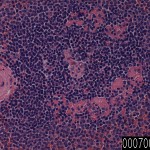| Product name | Spleen, normal |
| Cat. No. | 0007000A |
| No. of samples | 1 |
| Description | spleen, normal Age/Sex : 42/F |
| Price | 197 EUR |
| 260 USD | |
| 170 GBP |
Product Related Literature
Spleen is an organ found in all vertebrates virtually. It functions as a blood filter, mainly the same configuration as the large lymph nodes, it is possible without endangering life, to remove spleen. (Red blood cells are also called) red blood cells, the spleen plays an important role in the immune system. It has recycled iron, and also remove a pool of blood in the case of hemorrhagic shock and old red blood cells. As part of the drop mononuclear phagocyte system metabolism hemoglobin from red blood cell aging. Globin portion of hemoglobin is metabolized to bilirubin is decomposed into its constituent amino acids, heme portion is removed by the liver. The synthesized antibodies white mass, via the circulation of blood and lymph nodes, antibody-coated bacteria, spleen and removes the cells coated with antibody. Studies using mice have discovered that included monocytes in the spleen red pulp in reserve half, was published in 2009. While promoting the healing of tissue, move damaged tissue (such as heart), monocytes, these transform into macrophages and dendritic cells. Is central to the activity of the reticuloendothelial system, it is considered similar to a large lymph nodes, spleen, may be its absence causes susceptibility to a specific infection. In humans, the spleen is the color brownish, I is located in the upper left quadrant of the abdomen.
The spleen, in healthy adults, it is, about 22 cm long is (8.7 inches). It usually weighs between 200 g of (7.1 oz) 150 g (5.3 oz) . The easy way, is the rule of the 1 × 3 × 5 × 7 × 9 × 11 remember the anatomy of the spleen. Spleen is “3” 5 “, as well as the. Thymus was weighed 7 grams between the 11 ribs and ninth on the left, about weight, has the efferent lymphatic only spleen. Spleen lymphatic system splenic artery and short gastric artery is supplying it with blood as., which is part of.
Germinal center is supplied by the artery called penicilliary radicle. Spleen is unique in terms of its development in the gut. (Excluding adrenal neural crest origin) between the most inside the intestinal obtained endodermally, were obtained from the spleen mesenchymal tissue. Specifically, it is formed from the dorsal mesentery and spleen more. However, it is the same blood supply of the foregut organs such as the celiac trunk still. Consists mainly of pulp red light fin fish and cartilage, so as to be positioned on the inside of the serous lining of the intestine actually, usually is a little elongated body. Amphibian many, particularly in the frog, is required for a rounded shape, often is the mass of white.
Reptiles, birds, in mammals, allowing the richness relative, flesh of white, to adjust the shape of the part on the position of surrounding objects, but two groups of the latter, the spleen is usually normal. The majority of vertebrate continues to produce red blood lifetime spleen, it is mature, this feature can be lost only a mammal. Many mammals have a structure such as a small spleen called the blood unit within the body that is to have the same function as the spleen. Spleen aquatic mammals differ in some respects from those of mammals throughout. In general, they are gray in color. In Manatee whale, tend to be very small, but they, of their function for them to store red blood cells due to deep diving pinnipeds, may be very large. Vertebrate is hagfishes and lamprey only lacking the spleen. Has a structure similar to the red slurry even these animals, it is haematopoeitic tissue of the diffusion layers of the intestinal wall, which was estimated to be homologous to the spleen of higher vertebrates.
Creation of red blood cells. Bone marrow is the primary site of hematopoiesis in adult spleen, but I have an important hematopoietic function in 5 months pregnant largest. After delivery, the function of red blood cells, except for the blood diseases Some quit. As a central player in the reticuloendothelial system and the major lymphoid organs, and retain the ability to produce spleen lymphocytes remain, such as: the hematopoietic organs.

